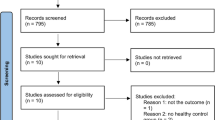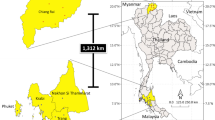Abstract
Longitudinal studies in Sudan show ethnic differences in incidence and clinical phenotypes associated with Leishmania donovani. Immunologically, bias in type 1 vs type 2 cytokine responses is important. To determine whether polymorphisms at IL4/IL9 or IFNGR1 contribute to susceptibility, we examined 59 multicase families of visceral leishmaniasis (VL) with/without post Kala-azar dermal leishmaniasis (PKDL). Multipoint nonparametric analysis (Allegro) linked IL4/IL9 to VL per se (P=0.002). Transmission disequilibrium testing with robust variance estimates confirmed association in the presence of linkage between VL per se and IL4 (P=0.008) but not IL9. Stepwise logistic regression analysis showed both IL4RP2 and IL4RP1 markers contributed significantly to the association, suggesting a common disease-associated haplotype. In contrast, IFNGR1 was linked (P=0.031) and associated (P=0.007) to PKDL but not VL or VL per se. Hence, polymorphism in a type 2 cytokine gene influences underlying susceptibility to VL, whereas IFNGR1 is specifically related to susceptibility to PKDL.
This is a preview of subscription content, access via your institution
Access options
Subscribe to this journal
Receive 6 digital issues and online access to articles
$119.00 per year
only $19.83 per issue
Buy this article
- Purchase on Springer Link
- Instant access to full article PDF
Prices may be subject to local taxes which are calculated during checkout
Similar content being viewed by others
References
Zijlstra EE, El Hassan AM, Ismael A, Ghalib HW . Endemic kala-azar in Eastern Sudan, a longitudinal study on the incidence of clinical and subclinical infection and post-kala-azar dermal leishmaniasis. Am J Trop Med Hyg 1994; 51: 826–836.
Kemp M, Kurtzhals JAL, Bendtzen K et al. Leishmania donovani-reactive Th1- and Th2-like T-cell clones from individuals who have recovered from visceral leishmaniasis. Infect Immun 1993; 61: 1069–1073.
Kemp K, Kemp M, Kharazmi A et al. Leishmania-specific T cells expressing interferon-gamma (IFN-gamma) and IL-10 upon activation are expanded in individuals cured of visceral leishmaniasis. Clin Exp Immunol 1999; 116: 500–504.
Kharazmi A, Kemp K, Ismail A et al. T-cell response in human leishmaniasis. Immunol Lett 1999; 65: 105–108.
Kurtzhals JA, Kemp M, Poulsen LK, Hansen MB, Kharazmi A, Theander TG . Interleukin-4 and interferon-gamma production by Leishmania stimulated peripheral blood mononuclear cells from nonexposed individuals. Scand J Immunol 1995; 41: 343–349.
Cordell HJ, Clayton DG . A unified stepwise regression procedure for evaluating the relative effects of polymorphisms within a gene using case/control or family data: application to HLA in type 1 diabetes. Am J Hum Genet 2002; 70: 124–141.
Zwingenberger K, Harms G, Pedrosa C, Omena S, Sandkamp B, Neifer S . Determinants of the immune response in visceral leishmaniasis: evidence for predominance of endogenous interleukin 4 over interferon-gamma production. Clin Immunol Immunopathol 1990; 57: 242–249.
Sundar S, Reed SG, Sharma S, Mehrotra A, Murray HW . Circulating T helper 1 (Th1) cell- and Th2 cell-associated cytokines in Indian patients with visceral leishmaniasis. Am J Trop Med Hyg 1997; 56: 522–525.
Gessner A, Blum H, Rollinghoff M . Differential regulation of IL-9-expression after infection with Leishmania major in susceptible and resistant mice. Immunobiology 1993; 189: 419–435.
Roberts M, Mock BA, Blackwell JM . Mapping of genes controlling Leishmania major infection in CXS recombinant inbred mice. Eur J Immunogenet 1993; 20: 349–362.
Mock BA, Krall M, Kozak CA et al. IL9 maps to mouse chromosome 13 and human chromosome 5. Immunogenetics 1990; 31: 265–270.
Matthews DJ, Emson CL, McKenzie GJ, Jolin HE, Blackwell JM, McKenzie AN . IL-13 is a susceptibility factor for Leishmania major infection. J Immunol 2000; 164: 1458–1462.
Newport MJ, Huxley CM, Huston S et al. A mutation in the interferon-γ-receptor gene and susceptibility to mycobacterial infection. N Engl J Med 1996; 26: 1941–1949.
Belkaid Y, Hoffmann KF, Mendez S et al. The role of interleukin (IL)-10 in the persistence of Leishmania major in the skin after healing and the therapeutic potential of anti-IL-10 receptor antibody for sterile cure. J Exp Med 2001; 194: 1497–1506.
Zijlstra EE, El-Hassan AM . Leishmaniasis in Sudan. 4. Post kala-azar dermal leishmaniasis. Trans R Soc Trop Med Hyg 2001; 95: S1/59–S1/76.
Musa AM, Khalil EAG, Rahemm MA et al. Natural history of Sudanese post Kala-azar demal leishmaniasis: clinical immunological and prognostic features. Trans R Soc Trop Med Hyg 2003; in press.
Mout R, Willemze R, Landegent JE . Repeat polymorphisms in the interleukin-4 gene (IL4). Nucleic Acids Res 1991; 19: 3763.
Polymeropoulos MH, Xiao H, Rath DS, Merril CR . Dinucleotide repeat polymorphism at the human interleukin 9 gene. Nucleic Acids Res 1991; 19: 688.
Altare F, Jouanguy E, Lamhamedi-Cherradi S et al. A causative relationship between mutant IFNgR1 alleles and impaired cellular response to IFNgamma in a compound heterozygous child. Am J Hum Genet 1998; 62: 723–726.
Gudbjartsson DF, Jonasson K, Frigge ML, Kong A . Allegro, a new computer program for multipoint linkage analysis. Nat Genet 2000; 25: 12–13.
Spielman RS, McGinnis RE, Ewens WJ . Transmission test for linkage disequilibrium: the insulin gene region and insulin-dependent diabetes mellitus (IDDM). Am J Hum Genet 1993; 52: 506–516.
Acknowledgements
We thank the people of Sudan who contributed to this study. The work was supported by grants from the Wellcome Trust and the UNDP/World Bank/WHO Special Programme for Research and Training in Tropical Diseases (TDR).
Author information
Authors and Affiliations
Corresponding author
Rights and permissions
About this article
Cite this article
Mohamed, H., Ibrahim, M., Miller, E. et al. Genetic susceptibility to visceral leishmaniasis in The Sudan: linkage and association with IL4 and IFNGR1. Genes Immun 4, 351–355 (2003). https://doi.org/10.1038/sj.gene.6363977
Published:
Issue Date:
DOI: https://doi.org/10.1038/sj.gene.6363977
Keywords
This article is cited by
-
Insights into the possible role of IFNG and IFNGR1 in Kala-azar and Post Kala-azar Dermal Leishmaniasis in Sudanese patients
BMC Infectious Diseases (2014)
-
UDP-Gal: N-acetylglucosamine β 1–4 galactosyltransferase expressing live attenuated parasites as vaccine for visceral leishmaniasis
Glycoconjugate Journal (2009)
-
Genes at human chromosome 5q31.1 regulate delayed-type hypersensitivity responses associated with Leishmania chagasi infection
Genes & Immunity (2007)
-
IFNG and IFNGR1 gene polymorphisms and susceptibility to post-kala-azar dermal leishmaniasis in Sudan
Genes & Immunity (2007)
-
Genetic susceptibility to infectious disease: lessons from mouse models of leishmaniasis
Nature Reviews Genetics (2006)



